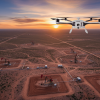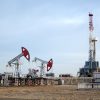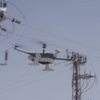Let’s consider how autonomous drones can help prevent failures and lead to industrial site maintenance cost savings.
Regular site inspections help maximize production
While some may scoff at the cost and question the necessity of regular site inspection, this is short-sighted. The inspection costs are a fraction of the costs that may be incurred if the site needs to be temporarily shut down to replace destroyed equipment.
Using a drone-in-a-box solution for site inspection helps maintain asset integrity. Consider, autonomous drones do not simply fly over an industrial site and send back pictures. Instead, they provide industrial asset monitoring. With the drone’s thermal imaging and AI-powered anomaly detection, it’s able to detect layer issues, leaks, and abnormal temperatures
The drones can also create insights and reports; they analyze visual data, and deliver actionable insights and reports directly to stakeholders.
Upon detecting the issue, the autonomous drone will instantly send an alert. With this information, reactive maintenance can resolve the anomaly before it develops into something more significant.
With regular site inspection of industrial assets, facilities can be better maintained, allowing production to continue as scheduled and reducing unplanned downtime.
Detect faults early on to keep heavy industrial sites safer
The classic philosophical debate – “If a tree falls in a forest and no one is around to hear it, does it make a sound?” – can be taken as a question of impact.
Well, an accident at a heavy industrial site can have an enormous impact. And the impact can spread beyond the site like in the case of the California utility noted above, where the accident caused deadly fires.
Even if/when the accident is contained, it can stain a company’s reputation and lead to outside inspections and reviews and increased legalities which drive up the cost of production. Of course, major accidents can also mean long-term shutdowns while a company is repairing/replacing assets.
With autonomous drones conducting regular site inspections, potential issues are detected before they become serious failures. Should an emergency situation arise, autonomous drones facilitate a faster response. They are able to assess emergency sites, in nearly any weather conditions, which can help first responders determine how to best handle the crisis.
This vital information provided by autonomous drones can save lives, protect the environment, and maintain the surrounding areas of the industrial site, as well as protect and maintain critical equipment.
Finally, autonomous drones can do site inspections of areas on a heavy industrial site that may be difficult to assess. Having an individual perform high-altitude inspections, for example, poses a few safety hazards for the inspector.
So, remote inspection enhances safety at heavy industrial sites. Knowing their workplace is safe, employees can feel more confident and comfortable in their work, allowing them to focus and even increase productivity.
Streamline compliance with regular site inspections
Non-compliance to rules and regulations is costly for heavy industrial sites, as it can lead to significant fines and penalties, and even temporary shutdowns.
Using autonomous drones for preventive maintenance tasks and site inspections not only helps keep an industrial site operating properly but also helps site owners be prepared for formal site reviews by government agencies.
Drones can constantly monitor and archive site conditions. This creates a record that can prove compliance and be shared with inspectors. The information gained can also serve as an alert to those at the industrial site. Irregularities can be addressed by maintenance prior to a formal investigation. Preventative maintenance will help with asset integrity management.
Just how costly is being out of compliance? Well, the average penalty at US Petroleum storage facilities in the first quarter of 2019 was $218K according to Reuters. Again, as costly as the fines are, shutting down a facility can be much more costly.
Reuters also notes the number of violations of the Clean Air and Clean Water Act was on the rise. Both the average penalty and the number of penalties had been decreasing in the middle of the 2010s but began increasing as the decade came to an end.
Another issue that is impacted by a company’s violations is its reputation. Because there’s a heightened sensitivity to environmental causes these days, being out of compliance when it comes to environmental-related issues can also be a public relations disaster.
In fact, a study from IBM and the National Retail Federation found that approximately 70% of American and Canadian consumers believe it’s important that brands are sustainable or eco-friendly. They’re also willing to pay more for products from eco-friendly companies.
With autonomous drones providing site inspection of heavy industrial sites, companies can remain compliant with laws and regulations, be viewed as conscientious environmental stewards, and maintain valuable equipment.
Having frequent high-quality inspections of industrial sites is a must. The best way to do this is via automated inspections powered by autonomous drones as they alleviate the challenges involved in inspecting heavy industrial sites. Regular site inspections act as preventative maintenance and keep a site operating effectively and efficiently.





